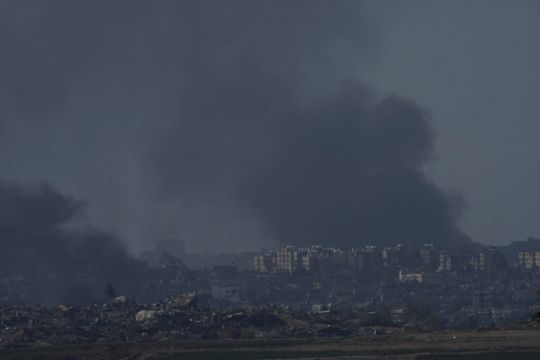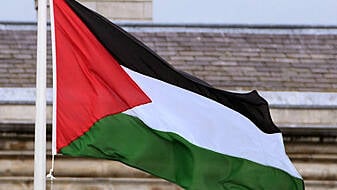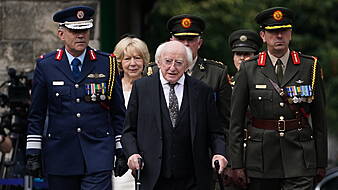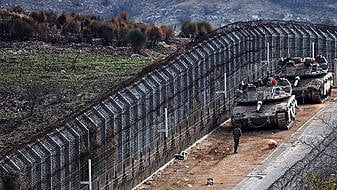Israel has said the military is rounding up Palestinian men in northern Gaza for interrogation amid a search for Hamas militants.
The move comes as desperate Palestinians in the south crowded into an ever-shrinking area, and the UN warned that its aid operation is “in tatters”.
The detentions pointed to Israeli efforts to secure the military’s hold on northern Gaza as the war entered its third month.
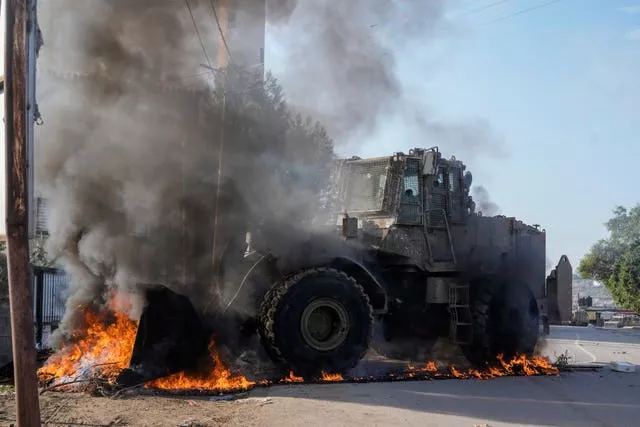
Furious urban fighting has continued in the north, underscoring Hamas’s heavy resistance, and tens of thousands of residents are believed to remain in the area six weeks after troops and tanks rolled in.
The first images of mass detentions emerged on Thursday from the northern town of Beit Lahiya, showing dozens of men kneeling or sitting in the streets, stripped down to their underwear, their hands bound behind their backs and some with their heads bowed.
UN monitors said Israeli troops reportedly detained men and boys from the age of 15 in a school-turned-shelter.
Israel has vowed to crush the military capabilities of Hamas, which rules Gaza, and remove it from power following the group’s October 7 attack that sparked the war.

Israel’s air and ground campaign initially focused on the northern half of Gaza, leading hundreds of thousands of residents to flee south.
A week ago, Israel expanded its ground assault into central and southern Gaza, where nearly the territory’s entire population of 2.3 million Palestinians are crowded, many of them cut off from humanitarian supplies.
In central Gaza, Israeli planes on Friday dropped leaflets on the refugee camps of Nuseirat and Maghazi with a message for Hamas officials.
“To Hamas leaders: A life for a life, an eye for an eye and whoever started is to blame. If you punish, then punish with the like of that wherewith you were afflicted,” the leaflet read.

Hours later, a strike shattered a residential building in the Nuseirat camp, killing at least 21 people, according to officials at the nearby hospital. Following the blast, residents were seen digging beneath the rubble, looking for survivors and belongings that could be unearthed.
Eylon Levy, an Israeli government spokesman, said on Friday that those detained in northern Gaza were “military-aged men who were discovered in areas that civilians were supposed to have evacuated weeks ago”.
Authorities were questioning the detainees to determine whether they were members of the militant group, Mr Levy said, indicating there would be more such sweeps going forward as troops move from north to south.
The London-based news outlet Al-Araby al-Jadeed, or The New Arab, said one of the men seen in the photos of the detainees is its Gaza correspondent Diaa al-Kahlout, and that he was rounded up with other civilians.

The Israeli assault has obliterated much of Gaza City and surrounding areas in the north.
Still, tens of thousands of residents are believed to remain there, though the UN says it cannot confirm exact numbers. Some are unable to move, others refuse to leave their homes, saying the overcrowded south is no safer or fearing they will not be allowed to return.
Heavy fighting has been under way for days in the Jabaliya refugee camp and the Gaza City district of Shujaiya.
The UN said Jabaliya’s Al Awda Hospital — one of two hospitals still operating in the north — was surrounded by Israeli forces and sustained damage due to Israeli shelling. It said Israeli sniper fire into the hospital has also been reported.

“Air strikes and random artillery shelling have continued intensely since last night until this morning,” said Hassan Al Najjar, a journalist speaking by phone from northern Gaza.
There also has been a dramatic surge in deadly military raids and an increase in restrictions on Palestinian residents in the occupied West Bank since the start of the war.
Israeli forces stormed into a refugee camp on Friday in the West Bank to arrest suspected Palestinian militants, unleashing fighting with local gunmen in which six Palestinians were killed, health officials said.
The continuation of tough fighting in the north raises fears that Israel’s move south to uproot Hamas will wreak similar devastation.

Earlier this week, UN secretary-general Antonio Guterres used a rarely exercised power to warn the Security Council of an impending “humanitarian catastrophe”, and Arab and predominantly Muslim nations called for a vote on Friday on a council resolution to demand an immediate ceasefire.
Mr Gutteres told the council that Gaza is at “a breaking point” and “there is a high risk of the total collapse of the humanitarian support system”.
But the United States, Israel’s closest ally, vetoed the UN resolution backed by the vast majority of Security Council members and many other nations. The vote in the 15-member council was 13-1, with the UK abstaining.
US concern over the devastation is growing. US officials told Israel ahead of the expansion of its ground offensive into southern Gaza that it must limit civilian deaths and displacement after the high death toll in the north.
Israel’s focus the past week has been on Khan Younis, the territory’s second-largest city. On Friday, the Palestinian Red Crescent Society said Israel’s air force attacked a home facing the society’s office in Khan Younis. It did not give details about casualties.

Tens of thousands of people displaced by the fighting have packed into the border city of Rafah, in the far south of the Gaza Strip, and Muwasi, a nearby patch of barren coastline. Israel has designated Muwasi as a safe zone. But the UN and relief agencies have called that a poorly planned solution.
With shelters significantly beyond capacity, many people pitched tents along the side of the road leading from Rafah to Muwasi.
“We do not have a humanitarian operation in southern Gaza that can be called by that name anymore,” the UN’s humanitarian chief, Martin Griffiths, said on Thursday.
The pace of Israel’s military assault “has made no place safe for civilians in southern Gaza, which had been a cornerstone of the humanitarian plan to protect civilians and thus to provide aid to them. But without places of safety, that plan is in tatters”.

Israel’s campaign has killed more than 17,400 people in Gaza — 70% of them women and children — and wounded more than 46,000, according to the territory’s Health Ministry, which says many others are trapped under rubble. The ministry does not differentiate between civilian and combatant deaths.
Hamas and other militants killed about 1,200 people, mostly civilians, in the October 7 attack and took more than 240 hostages.
More than 130 hostages remain in Gaza, predominately soldiers and civilian men, after more than 100 were freed, most during a ceasefire last month. The military says 93 of its troops have been killed in the ground campaign.
The Israeli military said on Friday that two soldiers were seriously wounded in a failed attempt to free Israeli hostages held in Gaza.
The military said that it killed numerous militants in the overnight operation, but was unable to rescue any hostages.
